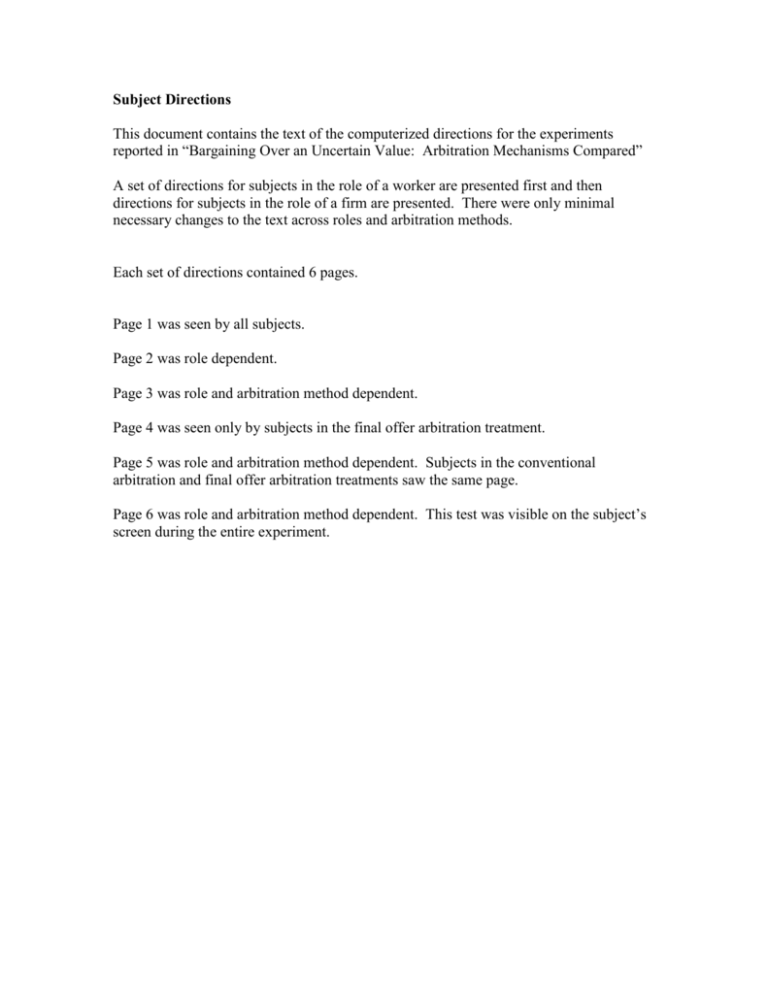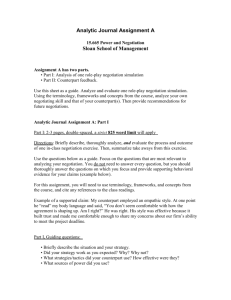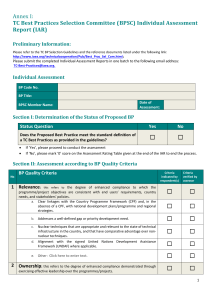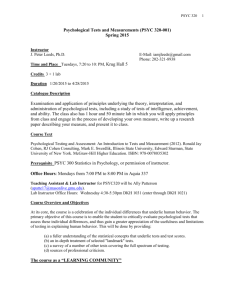Subject Directions
advertisement

Subject Directions This document contains the text of the computerized directions for the experiments reported in “Bargaining Over an Uncertain Value: Arbitration Mechanisms Compared” A set of directions for subjects in the role of a worker are presented first and then directions for subjects in the role of a firm are presented. There were only minimal necessary changes to the text across roles and arbitration methods. Each set of directions contained 6 pages. Page 1 was seen by all subjects. Page 2 was role dependent. Page 3 was role and arbitration method dependent. Page 4 was seen only by subjects in the final offer arbitration treatment. Page 5 was role and arbitration method dependent. Subjects in the conventional arbitration and final offer arbitration treatments saw the same page. Page 6 was role and arbitration method dependent. This test was visible on the subject’s screen during the entire experiment. Worker Directions Page 1 In this experiment you will have to make a series of decisions on the computer. Each period you and a randomly selected counterpart will have to decide how to allocate an amount of experimental money. You will be paid in cash at the end of the experiment based on the decisions you and your counterpart make. For every %s experimental dollars you earn you will be paid $US 1. If at any point you have a question please raise your hand and an experimenter will approach you. Otherwise, please do not talk during the experiment including this time while you and the others are going through the directions. Press “Next” to go to the next page of directions. Page 2 Each period you are going to propose an allocation of money by moving the slider at the top of your screen. Notice that there are two dark lines below the slider, each corresponding to a different amount of money. There are two lines because neither you nor your counterpart knows exactly how much money there is to allocate. However, you both know that the amount of money is equal to one of these two amounts. The actual amount to allocate is randomly determined and will be revealed after you and your counterpart have both made a decision. An allocation is defined as the amount of money that you will receive. Your counterpart will receive the rest of the available money. Your counterpart will also propose an allocation, an amount of money that you will receive, knowing that they will receive the remainder of the available money. To propose an allocation you must first move the slider to the desired amount. There is a table at the top of your screen that shows you what the payoffs to you and your counterpart would be if your proposed allocation were implemented. When you have placed the slider on the amount that you wish to propose you must press “Send Proposed Allocation.” Once you press this button in the experiment you cannot change your mind. Go ahead and propose an allocation now, don’t forget to press “Send Proposed Allocation.” Page 3 - No Arbitration Treatment Once you and your counterpart have each made a proposed allocation one of three things could happen. If the allocation that you proposed is exactly equal to the amount that your counterpart proposed then this is how the money will be allocated. If instead the allocation you proposed is less than the allocation your counterpart proposed, that is you placed the slider further to the left than did your counterpart, the actual allocation will be the average of the two proposals. However, if your proposed allocation was more than your counterpart’s proposed allocation, that is you placed the slider further to the right than did your counterpart, then the two proposals are not compatible. The proposals are not compatible because you proposed to receive more than your counterpart proposed for you to receive. In this case, both you and your counterpart will receive a payoff of 0. Press “Next” to go to the next page of directions. Page 3 - Conventional Arbitration Treatment Once you and your counterpart have each made a proposed allocation one of three things could happen. If the allocation that you proposed is exactly equal to the amount that your counterpart proposed then this is how the money will be allocated. If instead the allocation you proposed is less than the allocation your counterpart proposed, that is you placed the slider further to the left than did your counterpart, the actual allocation will be the average of the two proposals. However, if your proposed allocation was more than your counterpart’s proposed allocation, that is you placed the slider further to the right than did your counterpart, then the two proposals are not compatible. The proposals are not compatible because you proposed to receive more than your counterpart proposed for you to receive. In this case, the computer will randomly determine the allocation and you and your counterpart will have to pay the “cost if no allocation is determined initially.” This cost will be automatically deducted from your payoff. This cost information will be on your screen at all times. The computer knows how much money there is to be allocated and ignores the other amount when picking the allocation. Press “Next” to go to the next page of directions. Page 3 - Final Offer Arbitration Treatment Once you and your counterpart have each made a proposed allocation one of three things could happen. If the allocation that you proposed is exactly equal to the amount that your counterpart proposed then this is how the money will be allocated. If instead the allocation you proposed is less than the allocation your counterpart proposed, that is you placed the slider further to the left than did your counterpart, the actual allocation will be the average of the two proposals. However, if your proposed allocation was more than your counterpart’s proposed allocation, that is you placed the slider further to the right than did your counterpart, then the two proposals are not compatible. The proposals are not compatible because you proposed to receive more than your counterpart proposed for you to receive. In this case, the computer will determine the allocation and you and your counterpart will have to pay the “cost if no allocation is determined initially.” This cost will be automatically deducted from your payoff. This cost information will be on your screen at all times. Press “Next” to find out how the computer will determine the allocation in this case. Page 4 – Final Offer Arbitration Treatment Only If the proposals that you and your counterpart make are not compatible, then both you and your counterpart will be asked to send another amount for the computer to consider as an allocation. After you and your counterpart have both typed an amount into the box on the right side of the screen and pressed “Send Amount” the computer will determine the allocation. The computer knows how much money there is to be allocated and ignores the other amount. To determine the allocation the computer first randomly picks a potential allocation based on how much money is available. The computer then compares this randomly determined amount to the amounts you and your counterpart typed. Whichever amount sent by you or your counterpart is closer to the amount the computer randomly picked will be used as the allocation. This allocation will determine your payoff and your counterpart’s payoff. In the event that the differences are the same, the computer will randomly pick one of the two sent amounts to be the allocation. The allocation will be either the amount you sent or the amount your counterpart sent. Page 5 – No Arbitration Treatment Now a table has appeared on your screen. After each period the following information will be displayed in the bottom row of this table: 1) your proposed allocation, 2) your counterpart’s proposed allocation, 3) the allocation, 4) your payoff, and 5) your counterpart’s payoff. Recall that your payoff is the allocation. Your counterpart’s payoff is the amount of money available minus the allocation. Notice that your counterpart would lose money if the allocation were greater than the amount of money available. If you have any questions please raise your hand. If you are finished with the directions please press “Begin” and then wait quietly for further instructions. Page 5 – Final Offer and Conventional Arbitration Treatments Now a table has appeared on your screen. After each period the following information will be displayed in the bottom row of this table: 1) your proposed allocation, 2) your counterpart’s proposed allocation, 3) the allocation, 4) your payoff, and 5) your counterpart’s payoff. Recall that your payoff is the allocation minus your cost if applicable. Your counterpart’s payoff is the amount of money available minus the allocation minus his or her cost if applicable. Notice that your counterpart would lose money if the allocation were greater than the amount of money available. If you have any questions please raise your hand. If you are finished with the directions please press “Begin” and then wait quietly for further instructions. Page 6 – No Arbitration Treatment Neither you nor your counterpart knows how much money there is to be allocated, but you both know that it is one of the two amounts on the left of your screen. If the proposed allocations are compatible then the actual allocation will be the average of the proposed allocations. You will receive the allocation and your counterpart will receive the available money minus the allocation. If the proposals are incompatible then both you and your counterpart will receive 0. Page 6 – Conventional Arbitration Treatment Neither you nor your counterpart knows how much money there is to be allocated, but you both know that it is one of the two amounts on the top of your screen. If the proposed allocations are compatible then the actual allocation will be the average of the proposed allocations. You will receive the allocation and your counterpart will receive the available money minus the allocation. If the proposals are incompatible then the computer will randomly determine the allocation. In this case the cost will be deducted from your payoff and your counterpart’s payoff. Page 6 – Final Offer Arbitration Treatment Neither you nor your counterpart knows how much money there is to be allocated, but you both know that it is one of the two amounts on the top of your screen. If the proposed allocations are compatible then the actual allocation will be the average of the proposed allocations. You will receive the allocation and your counterpart will receive the available money minus the allocation. If the proposals are incompatible then you and your counterpart will be asked to send an amount for the computer to consider. The computer will randomly select an amount and choose as the allocation the amount sent by you or your counterpart, which is closest to this randomly determined amount. In this case the cost will be deducted from your payoff and your counterpart’s payoff. Firm Directions Page 1 In this experiment you will have to make a series of decisions on the computer. Each period you and a randomly selected counterpart will have to decide how to allocate an amount of experimental money. You will be paid in cash at the end of the experiment based on the decisions you and your counterpart make. For every %s experimental dollars you earn you will be paid $US 1. If at any point you have a question please raise your hand and an experimenter will approach you. Otherwise, please do not talk during the experiment including this time while you and the others are going through the directions. Press “Next” to go to the next page of directions. Page 2 Each period you are going to propose an allocation of money by moving the slider at the top of your screen. Notice that there are two dark lines below the slider, each corresponding to a different amount of money. There are two lines because neither you nor your counterpart knows exactly how much money there is to allocate. However, you both know that the amount of money is equal to one of these two amounts. The actual amount to allocate is randomly determined and will be revealed after you and your counterpart have both made a decision. An allocation is defined as the amount of money that your counterpart will receive. You will receive the rest of the available money. Your counterpart will also propose an allocation, an amount of money that your counterpart will receive, knowing that you will receive the remainder of the available money. To propose an allocation you must first move the slider to the desired amount. There is a table at the top of your screen that shows you what the payoffs to you and your counterpart would be if your proposed allocation were implemented. When you have placed the slider on the amount that you wish to propose you must press “Send Proposed Allocation.” Once you press this button in the experiment you cannot change your mind. Go ahead and propose an allocation now, don’t forget to press “Send Proposed Allocation.” Page 3 - No Arbitration Treatment Once you and your counterpart have each made a proposed allocation one of three things could happen. If the allocation that you proposed is exactly equal to the amount that your counterpart proposed then this is how the money will be allocated. If instead the allocation you proposed is more than the allocation your counterpart proposed, that is you placed the slider further to the right than did your counterpart, the actual allocation will be the average of the two proposals. However, if your proposed allocation was less than your counterpart’s proposed allocation, that is you placed the slider further to the left than did your counterpart, then the two proposals are not compatible. The proposals are not compatible because your counterpart proposed to receive more than you proposed for him or her to receive. In this case, both you and your counterpart will receive a payoff of 0. Press “Next” to go to the next page of directions. Page 3 - Conventional Arbitration Treatment Once you and your counterpart have each made a proposed allocation one of three things could happen. If the allocation that you proposed is exactly equal to the amount that your counterpart proposed then this is how the money will be allocated. If instead the allocation you proposed is more than the allocation your counterpart proposed, that is you placed the slider further to the right than did your counterpart, the actual allocation will be the average of the two proposals. However, if your proposed allocation was less than your counterpart’s proposed allocation, that is you placed the slider further to the left than did your counterpart, then the two proposals are not compatible. The proposals are not compatible because your counterpart proposed to receive more than you proposed for him or her to receive. In this case, the computer will randomly determine the allocation and you and your counterpart will have to pay the “cost if no allocation is determined initially.” This cost will be automatically deducted from your payoff. This cost information will be on your screen at all times. The computer knows how much money there is to be allocated and ignores the other amount when picking the allocation. Press “Next” to go to the next page of directions. Page 3 - Final Offer Arbitration Treatment Once you and your counterpart have each made a proposed allocation one of three things could happen. If the allocation that you proposed is exactly equal to the amount that your counterpart proposed then this is how the money will be allocated. If instead the allocation you proposed is more than the allocation your counterpart proposed, that is you placed the slider further to the right than did your counterpart, the actual allocation will be the average of the two proposals. However, if your proposed allocation was less than your counterpart’s proposed allocation, that is you placed the slider further to the left than did your counterpart, then the two proposals are not compatible. The proposals are not compatible because your counterpart proposed to receive more than you proposed for him or her to receive. In this case, the computer will determine the allocation and you and your counterpart will have to pay the “cost if no allocation is determined initially.” This cost will be automatically deducted from your payoff. This cost information will be on your screen at all times. Press “Next” to find out how the computer will determine the allocation in this case. Page 4 – Final Offer Arbitration Treatment Only If the proposals that you and your counterpart make are not compatible, then both you and your counterpart will be asked to send another amount for the computer to consider as an allocation. After you and your counterpart have both typed an amount into the box on the right side of the screen and pressed “Send Amount” the computer will determine the allocation. The computer knows how much money there is to be allocated and ignores the other amount. To determine the allocation the computer first randomly picks a potential allocation based on how much money is available. The computer then compares this randomly determined amount to the amounts you and your counterpart typed. Whichever amount sent by you or your counterpart is closer to the amount the computer randomly picked will be used as the allocation. This allocation will determine your payoff and your counterpart’s payoff. In the event that the differences are the same, the computer will randomly pick one of the two sent amounts to be the allocation. The allocation will be either the amount you sent or the amount your counterpart sent. Page 5 – No Arbitration Treatment Now a table has appeared on your screen. After each period the following information will be displayed in the bottom row of this table: 1) your proposed allocation, 2) your counterpart’s proposed allocation, 3) the allocation, 4) your payoff, and 5) your counterpart’s payoff. Recall that your payoff is the amount of money available minus the allocation. Notice that you would lose money if the allocation were greater than the amount of money available. Your counterpart’s payoff is the allocation. If you have any questions please raise your hand. If you are finished with the directions please press “Begin” and then wait quietly for further instructions. Page 5 – Final Offer and Conventional Arbitration Treatments Now a table has appeared on your screen. After each period the following information will be displayed in the bottom row of this table: 1) your proposed allocation, 2) your counterpart’s proposed allocation, 3) the allocation, 4) your payoff, and 5) your counterpart’s payoff. Recall that your payoff is the amount of money available minus the allocation minus your cost if applicable. Notice that you would lose money if the allocation were greater than the amount of money available. Your counterpart’s payoff is the allocation minus his or her cost if applicable. If you have any questions please raise your hand. If you are finished with the directions please press “Begin” and then wait quietly for further instructions. Page 6 – No Arbitration Treatment Neither you nor your counterpart knows how much money there is to be allocated, but you both know that it is one of the two amounts on the top of your screen. If the proposed allocations are compatible then the actual allocation will be the average of the proposed allocations. Your counterpart will receive the allocation and you will receive the available money minus the allocation. If the proposals are incompatible then both you and your counterpart will receive 0. Page 6 – Conventional Arbitration Treatment Neither you nor your counterpart knows how much money there is to be allocated, but you both know that it is one of the two amounts on the top of your screen. If the proposed allocations are compatible then the actual allocation will be the average of the proposed allocations. Your counterpart will receive the allocation and you will receive the available money minus the allocation. If the proposals are incompatible then the computer will randomly determine the allocation. In this case the cost will be deducted from your payoff and your counterpart’s payoff. Page 6 – Final Offer Arbitration Treatment Neither you nor your counterpart knows how much money there is to be allocated, but you both know that it is one of the two amounts on the top of your screen. If the proposed allocations are compatible then the actual allocation will be the average of the proposed allocations. Your counterpart will receive the allocation and you will receive the available money minus the allocation. If the proposals are incompatible then you and your counterpart will be asked to send an amount for the computer to consider. The computer will randomly select an amount and choose as the allocation the amount sent by you or your counterpart, which is closest to this randomly determined amount. In this case the cost will be deducted from your payoff and your counterpart’s payoff.








